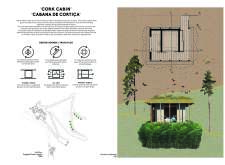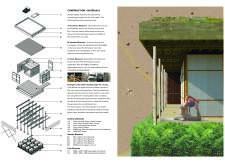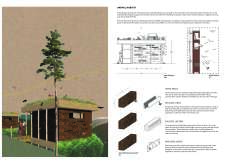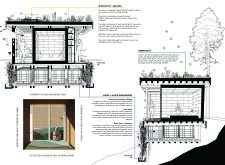5 key facts about this project
### Innovative Use of Local Materials
A significant aspect of the Cork Cabin is its use of cork as the primary building material. Sourced sustainably, expanded cork bricks are utilized throughout the structure for their thermal insulation properties and environmental benefits. The cabin's envelope is complemented by pine boards, eucalyptus trunks, and plywood, which contribute to the overall structural integrity and aesthetic continuity of the design. This selection of materials not only supports local economies but also reduces the carbon footprint associated with construction, aligning with the project's emphasis on environmental stewardship.
### Integration with the Environment
The design reflects an intentional relationship with its ecosystem. The layout facilitates interaction with the landscape, featuring large openings and terraces that encourage outdoor engagement. The green roof design promotes biodiversity by creating habitats for local flora and fauna while also providing additional insulation for energy efficiency. Rainwater harvesting and blackwater composting systems enhance the project's sustainability by minimizing resource consumption and incorporating natural processes in waste management.
The structure includes thoughtful details such as dedicated niches for wildlife, promoting ecological awareness among visitors. This approach not only informs guests about local biodiversity but also fosters a sense of coexistence with nature. The architectural design aims to create an immersive experience, where occupants can reflect, meditate, and engage in physical activity, enhancing overall well-being.
The Cork Cabin serves as a model for future architectural endeavors that seek to harmonize with their environments while promoting sustainable living practices.
For more insights into the architectural plans, sections, and detailed designs of the Cork Cabin, explore the project presentation to fully appreciate its unique contributions to contemporary architecture.


























